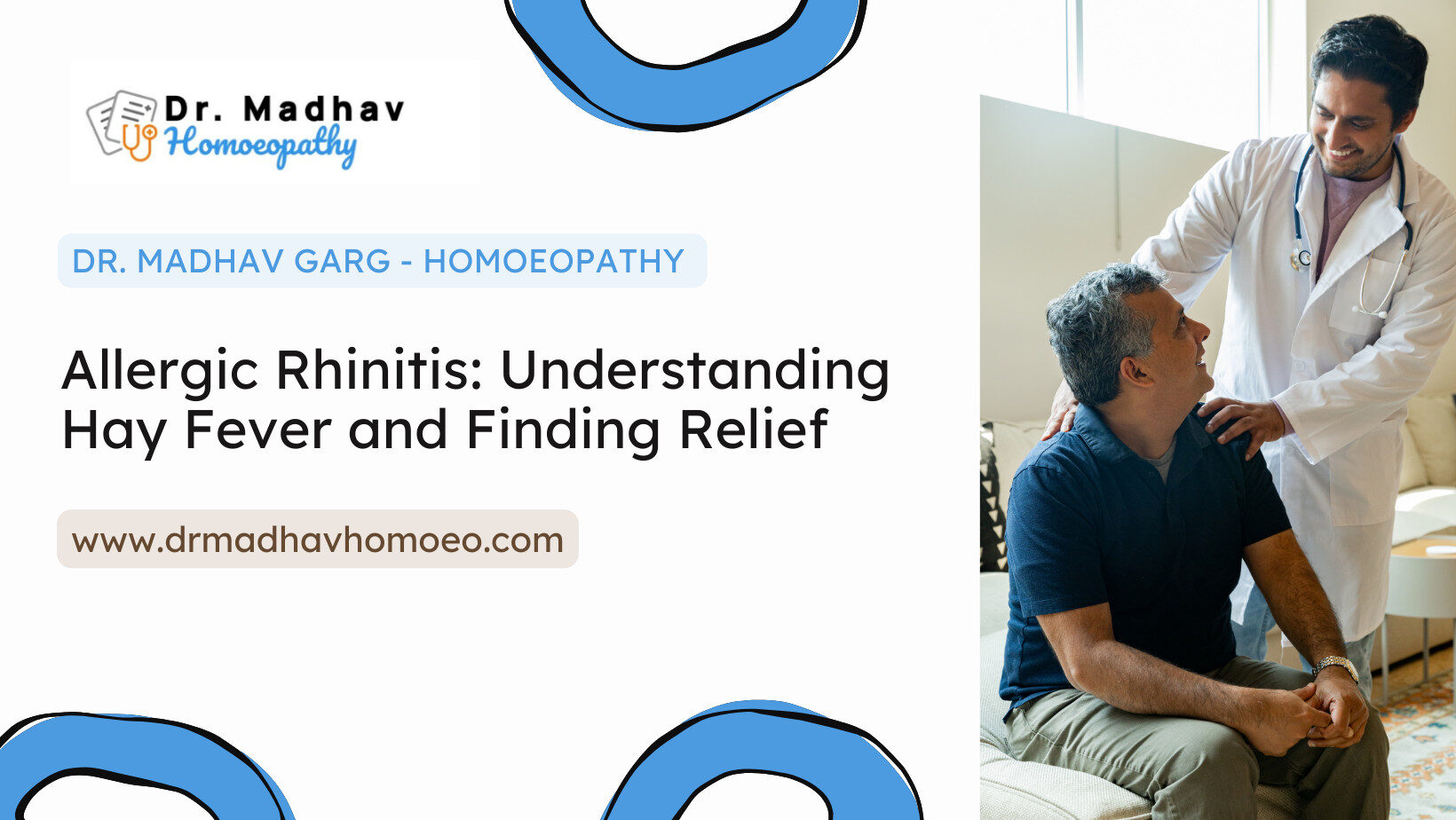Allergic rhinitis – commonly known as hay fever (for its seasonal form) – is an inflammatory condition of the nasal passages caused by an allergic reaction. It occurs when the immune system overreacts to normally harmless substances (allergens) like pollen or dust, triggering an IgE-mediated release of inflammatory chemicals in the nose. This leads to classic allergy symptoms such as runny or stuffy nose, sneezing, and nasal itching, often accompanied by itchy, watery eyes and throat irritation.
Beyond just a “runny nose,” allergic rhinitis can significantly impact daily life – causing fatigue, poor sleep, difficulty concentrating, and even contributing to sinusitis or asthma flare-ups. Sufferers may feel constantly tired or irritable, and many report that their allergy symptoms interfere with work, school, and overall quality of life.
Looking for safe, natural, and personalized homeopathic treatment? Dr. Madhav Garg, BHMS, is dedicated to holistic healing and patient-centered care at Dr. Madhav Garg’s Homeopathic Clinic in Gurugram. Whether you need expert consultation, customized remedies, or natural solutions for chronic health concerns, Dr. Garg is here to help! Book your appointment today or call ☎ (+91) 084477 93878 to experience the benefits of homeopathy firsthand. Your journey to better health starts here!
How Common Is Allergic Rhinitis?
Allergic rhinitis is one of the most common chronic conditions worldwide, and its prevalence has been rising. Globally, between 10% and 30% of the population is affected by allergic rhinitis. That translates to hundreds of millions of people – estimates suggest over 400 million people around the world suffer from allergic rhinitis. In Western countries, roughly 1 in 5 people has this allergy condition.
Allergic rhinitis often begins in childhood or young adulthood and may persist for life, and evidence shows its prevalence is increasing globally due to factors like pollution and changing environmental exposures.
Causes and Common Triggers of Allergic Rhinitis
Allergic rhinitis happens when you breathe in an allergen that your immune system misidentifies as a threat. Common allergens that trigger hay fever include: pollen from trees, grasses, and weeds (a major culprit in seasonal allergies), dust mites (microscopic insects in house dust), animal dander from pets (shed skin flakes, saliva, etc.), and mold spores.
Less obvious triggers like cockroach droppings can also cause year-round allergic rhinitis in some cases. When a susceptible person inhales these allergens, it sets off an IgE antibody response and the release of histamine and other inflammatory mediators in the nasal tissues, leading to the familiar allergy symptoms.

Both genetics and environment play a role in who develops allergic rhinitis. If you have a family history of allergies or asthma, you are more likely to develop hay fever. Being exposed to allergens early and often can sensitize your immune system – for instance, a child growing up with pets may become allergic to pet dander.
On the other hand, some exposures might protect: children raised on farms or with multiple siblings (which can mean more microbial exposure) seem to have a lower risk of allergies, an observation often cited in the “hygiene hypothesis”. Environmental factors like air pollution, tobacco smoke, and climate changes (which can alter pollen production) are also thought to increase the risk or severity of allergic rhinitis.
Notably, non-allergic triggers such as strong odors, smoke, or cold air don’t cause true allergic rhinitis, but they can irritate the nasal passages and provoke similar symptoms or worsen an ongoing allergic reaction. Identifying one’s personal triggers is important – some people react vigorously to spring tree pollen but not to mold, for example.
Symptoms of Allergic Rhinitis and Their Impact
Allergic rhinitis symptoms can range from mild sniffles to debilitating congestion. They typically start promptly upon exposure to allergens (often within minutes) and can persist as long as the exposure continues.
Common symptoms include:
- Nasal congestion (stuffy nose due to swollen nasal tissues)
- Rhinorrhea (runny nose) and post-nasal drip (mucus draining down the throat)
- Sneezing fits (often multiple sneezes in a row)
- Itching in the nose, throat, or roof of the mouth (some also get itchy ears)
- Red, watery eyes (allergic conjunctivitis often accompanies rhinitis)
- Swelling or puffiness around the eyes
Many people also experience a cough (from throat irritation or post-nasal drip) and reduced sense of smell when congested. The nasal discharge in allergies is typically clear and thin, as opposed to the thicker discolored mucus of a common cold.
Seasonal vs. Perennial Allergic Rhinitis
Allergic rhinitis is often classified into two main types based on timing of symptoms: seasonal and perennial.
- Seasonal allergic rhinitis is what we commonly call “hay fever.” Symptoms occur during specific seasons when certain pollens or molds are prevalent in the air. For instance, someone allergic to tree pollen will have flare-ups in spring when trees bloom, while a ragweed allergy causes misery in late summer and fall. During these times, sufferers endure intense sneezing, runny nose, and itchy eyes; outside of those seasons, they may have no symptoms at all.
- Perennial allergic rhinitis causes symptoms year-round. People with perennial allergies are exposed to allergens continuously in their daily environment, so they experience chronic mild-to-moderate symptoms almost any time of year. These individuals often wake up with nasal congestion or suffer persistent nasal stuffiness and intermittent sneezing on an ongoing basis. Symptoms might be somewhat less dramatic than seasonal hay fever bursts, but the constant nature can be very frustrating.
Diagnosing Allergic Rhinitis
Diagnosing allergic rhinitis usually starts with a clinical evaluation – your healthcare provider will consider your symptoms, their timing, and your exposures. Clues like sneezing and itchiness that occur every spring or symptoms that flare up when cleaning a dusty room strongly suggest allergies.
The doctor will also perform a physical exam, looking for signs such as swollen, pale nasal mucosa, nasal drainage, or red watery eyes typical of allergies. Often, this history and exam are enough to make a presumptive diagnosis of allergic rhinitis.
To confirm the specific allergens causing your symptoms, or if the diagnosis is uncertain, allergy testing may be done. The two standard tests are skin prick tests and blood IgE tests.
Conclusion
Allergic rhinitis may be common, but you don’t have to let it run your life. By understanding your triggers and combining smart avoidance strategies with effective treatments, you can keep the sneezes and sniffles under control and maintain a good quality of life even in the midst of pollen season. And if one approach isn’t working, don’t give up – consult an allergist or healthcare provider to adjust your plan. Often, a tailored regimen can make a world of difference for chronic hay fever.
Living with allergic rhinitis is an ongoing process of management, but armed with knowledge and the right strategies, you can significantly reduce its impact. After all, everyone deserves to enjoy the outdoors in spring or snuggle their pet without constant discomfort.
Sources: Allergy Statistics | AAAAI , Hay Fever (Rhinitis), Symptoms & Treatment | ACAAI Public Website. All claims and recommendations are supported by these sources.









